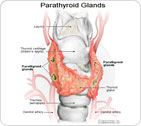Testing for primary hyperparathyroidism
Blood Tests
 In the majority of cases, the diagnosis of hyperparathyroidism is relatively straightforward. A patient will have high calcium levels in the blood along with a high PTH level. This tells us that the body is not responding appropriately to the high calcium levels by decreasing parathyroid hormone. Instead, one or more bad parathyroid glands is producing PTH, causing the body to absorb and retain more calcium than it should. Using this same logic, we can also say that a ‘normal’ PTH level in light of a high calcium level is inappropriate, as the PTH level really should be low. So we would call this ‘inappropriately normal.’ So, to summarize, a normal or high PTH level in the presence of high calcium typically equals parathyroid disease.
In the majority of cases, the diagnosis of hyperparathyroidism is relatively straightforward. A patient will have high calcium levels in the blood along with a high PTH level. This tells us that the body is not responding appropriately to the high calcium levels by decreasing parathyroid hormone. Instead, one or more bad parathyroid glands is producing PTH, causing the body to absorb and retain more calcium than it should. Using this same logic, we can also say that a ‘normal’ PTH level in light of a high calcium level is inappropriate, as the PTH level really should be low. So we would call this ‘inappropriately normal.’ So, to summarize, a normal or high PTH level in the presence of high calcium typically equals parathyroid disease.
Normally, calcium in the blood is measured as ‘total serum calcium,’ which includes all the calcium in the blood that is bound to protein. Although the calcium which is bound to proteins is not active in the body, it is usually reflective of the free (or ionized) calcium which is biologically active. Exceptions to this include alterations in the pH or temperature of the blood, or the amount of protein present in the serum. In these cases, it is useful to measure the ionized (or active) calcium directly to determine whether the levels are truly high. Similarly, measuring the amount of calcium in the urine can indicate how much calcium the body is holding onto or excreting, thereby aiding the diagnosis. Patients who are suspected to have parathyroid disease but have a normal serum calcium may go on to have their ionized calcium and urine calcium levels measured.
Ultrasound Localization
Sestamibi has traditionally been the best test to identify an abnormal parathyroid gland. This test is very time intensive and the results are very variable depending on where the study is performed. At the Parikh Parathyroid Center we have replaced Sestamibi scanning with ultrasound. Even in patients with negative sestamibi scans we are able to find parathyroid adenomas 75% of the time with high resolution ultrasound. More importantly this procedure is done in the office on your first visit by Dr. Parikh and takes about 5 minutes.
Sestamibi Scan
A Technetium (99mTc) sestamibi scan can be ordered by your physician to help determine which of the four parathyroid glands is overproducing PTH, or to locate an ectopic parathyroid gland that may be in the chest somewhere. This test works because the hyperactive parathyroid gland will take up more of the 99mTc tracer than the other dormant parathyroid glands. This increased uptake is then visualized by using a special camera to view the radioactive particles that are emitted by the tracer and mapping the increased activity to the overactive gland. This test is not typically needed in the diagnosis of hyperparathyroidism, but is useful just before surgery to localize the overactive gland once the diagnosis has been established.
